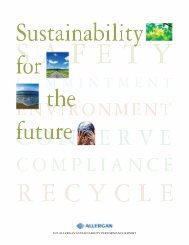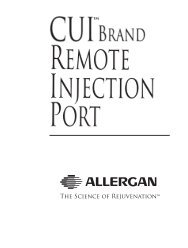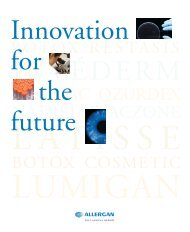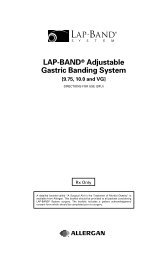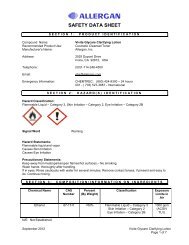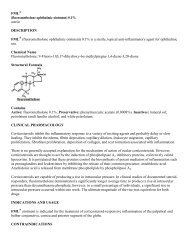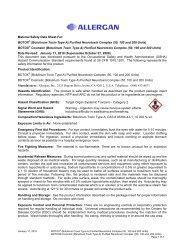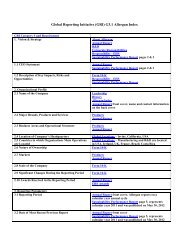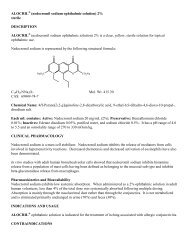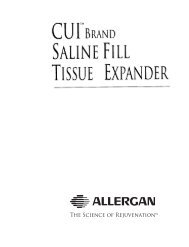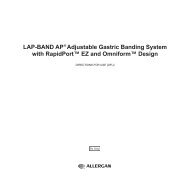Style 133V Series Tissue Expander Matrix - Allergan
Style 133V Series Tissue Expander Matrix - Allergan
Style 133V Series Tissue Expander Matrix - Allergan
Create successful ePaper yourself
Turn your PDF publications into a flip-book with our unique Google optimized e-Paper software.
Directions for UseDirections for Use<strong>Style</strong> <strong>133V</strong><strong>Series</strong><strong>Tissue</strong><strong>Expander</strong><strong>Matrix</strong>WITH MAGNA-SITE ®INJECTION SITES
CAUTION: U.S. Federal law restricts this device to sale by or on theorder of a licensed physician.
TABLE OF CONTENTSSectionPage<strong>Style</strong>s Included . . . . . . . . . . . . . . . . . . . . . . . . . . . . . . . . . . . . . . . . . . . . . . .2Description . . . . . . . . . . . . . . . . . . . . . . . . . . . . . . . . . . . . . . . . . . . . . . . . . .3Indications . . . . . . . . . . . . . . . . . . . . . . . . . . . . . . . . . . . . . . . . . . . . . . . . . .4Contraindications . . . . . . . . . . . . . . . . . . . . . . . . . . . . . . . . . . . . . . . . . . . . .5Information That Should Be Provided to the Patient . . . . . . . . . . . . . . . . . . .5Warnings . . . . . . . . . . . . . . . . . . . . . . . . . . . . . . . . . . . . . . . . . . . . . . . . . . .6Precautions . . . . . . . . . . . . . . . . . . . . . . . . . . . . . . . . . . . . . . . . . . . . . . . . .8Adverse Reactions . . . . . . . . . . . . . . . . . . . . . . . . . . . . . . . . . . . . . . . . . . .10Research on Silicone Implants . . . . . . . . . . . . . . . . . . . . . . . . . . . . . . . . . .13Instructions for Use . . . . . . . . . . . . . . . . . . . . . . . . . . . . . . . . . . . . . . . . . .15Surgical Procedure . . . . . . . . . . . . . . . . . . . . . . . . . . . . . . . . . . . . . . . . .15Single Use . . . . . . . . . . . . . . . . . . . . . . . . . . . . . . . . . . . . . . . . . . . . . . . .15Product Identification . . . . . . . . . . . . . . . . . . . . . . . . . . . . . . . . . . . . . . .15Sterile Product . . . . . . . . . . . . . . . . . . . . . . . . . . . . . . . . . . . . . . . . . . . .15Product Accessories . . . . . . . . . . . . . . . . . . . . . . . . . . . . . . . . . . . . . . . .16How to Open Product Package . . . . . . . . . . . . . . . . . . . . . . . . . . . . . . . .16Preliminary Product Examination . . . . . . . . . . . . . . . . . . . . . . . . . . . . . .16Techniques for Using Breast <strong>Tissue</strong> <strong>Expander</strong>s . . . . . . . . . . . . . . . . . . .17MAGNA-FINDER ® Cleaning and Resterilization Instructions . . . . . . . . . . .21Reporting and Return of Explanted Devices . . . . . . . . . . . . . . . . . . . . . . . .23Returned Goods Policy . . . . . . . . . . . . . . . . . . . . . . . . . . . . . . . . . . . . . . . .23Limited Warranty, Limitation of Liability and Disclaimer . . . . . . . . . . . . . . .23Product Ordering . . . . . . . . . . . . . . . . . . . . . . . . . . . . . . . . . . . . . . . . . . . .23Page 1
STYLES INCLUDEDSTYLE 133 FVShaped <strong>Tissue</strong> <strong>Expander</strong>Full Height, Variable ProjectionSaline-FilledBIOCELL ® TexturedMAGNA-SITE ® Injection SiteSTYLE 133 MVShaped <strong>Tissue</strong> <strong>Expander</strong>Moderate Height, Variable ProjectionSaline-FilledBIOCELL ® TexturedMAGNA-SITE ® Injection SiteSTYLE 133 SVShaped <strong>Tissue</strong> <strong>Expander</strong>Short Height, Variable ProjectionSaline-FilledBIOCELL ® TexturedMAGNA-SITE ® Injection SiteSTYLE 133 LVShaped <strong>Tissue</strong> <strong>Expander</strong>Low Height, Variable ProjectionSaline-FilledBIOCELL ® TexturedMAGNA-SITE ® Injection SitePage 2
DESCRIPTIONThe <strong>Allergan</strong> <strong>Style</strong> <strong>133V</strong> <strong>Series</strong> <strong>Tissue</strong> <strong>Expander</strong> <strong>Matrix</strong> is intended for temporary subcutaneousimplantation and requires periodic, incremental inflation with sterile saline forinjection until the desired amount of tissue is developed.<strong>Allergan</strong>’s <strong>Style</strong> <strong>133V</strong> <strong>Series</strong> <strong>Tissue</strong> <strong>Expander</strong>s are constructed from silicone elastomerand consist of an expansion envelope with a BIOCELL ® textured surface, and aMAGNA-SITE ® integrated injection site. The expanders are available in a wide range ofstyles and sizes to meet diverse surgical needs. Specific styles are described above,under <strong>Style</strong>s Included.All <strong>Allergan</strong> <strong>Style</strong> <strong>133V</strong> <strong>Series</strong> <strong>Tissue</strong> <strong>Expander</strong>s with the MAGNA-SITE ® integratedinjection port are supplied with a sterile MAGNA-FINDER ® external locating device. Inaddition, <strong>Tissue</strong> <strong>Expander</strong> Fill Kits, BIOCELL ® Delivery Assistance Sleeves and otherproduct accessories are available separately.For more information on specific styles and accessories, please contact your <strong>Allergan</strong>Breast Aesthetics Business Development Manager, or the Customer Care Departmentat 1.800.766.0171.Breast <strong>Tissue</strong> <strong>Expander</strong> Shapes• <strong>Allergan</strong>’s <strong>Style</strong> <strong>133V</strong> <strong>Series</strong> <strong>Tissue</strong> <strong>Expander</strong>s are designed as part of a systemfor breast reconstruction to create a pocket for placement of a NATRELLEbreast implant.Shell Characteristics• BIOCELL ® textured surface is designed to promote mild tissue adherence andbreast tissue expander immobility.• Stable bases for greater control over expansion direction are available on allstyles.Page 3
DESCRIPTION (cont’d)Injection Sites• The MAGNA-SITE ® injection site and MAGNA-FINDER ® external locating devicecontain rare-earth, permanent magnets for an accurate injection system. Whenthe MAGNA-FINDER ® external locating device is passed over the surface of thetissue being expanded as described in INSTRUCTIONS FOR USE, its rare-earth,permanent magnet indicates the location of the MAGNA-SITE ® injection site.• All injection sites contain a self-sealing port and a titanium needle guard (seeFigure 1) to prevent inadvertent puncture through the base of the injection site.Figure 1:MAGNA-SITE ®& MAGNA-FINDER ®Locating SystemNOTE: In vitro tests show that the MAGNA-SITE ® injection site is detectable through60 mm of phantom tissue.CAUTION: DO NOT use MAGNA-SITE ® breast tissue expanders in patients whoalready have implanted devices that would be affected by a magnetic field (e.g.,pacemakers, drug infusion devices, artificial sensing devices). DO NOT perform diagnostictesting with Magnetic Resonance Imaging (MRI) in patients with MAGNA-SITE ® breasttissue expanders in place.See Magnetic Field under WARNINGS for more information.THE INDICA TIONS AND CONTRAINDICATIONS BELOW ARE GENERALIZED. EACH PATIENT MUSTBE INDIVIDUALLY EVALUATED FOR TISSUE EXPANSION BASED ON THE MEDICAL JUDGMENT OF AQUALIFIED SURGEON.INDICATIONS• Breast reconstruction following mastectomy.• Treatment of underdeveloped breasts.• Treatment of soft tissue deformities.Page 4
CONTRAINDICATIONS• MAGNA-SITE ® breast tissue expanders should not be used in patients whoalready have implanted devices that would be affected by a magnetic field (e.g.,pacemakers, drug infusion devices, artificial sensing devices).• <strong>Tissue</strong> at the intended expansion site determined unsuitable by the surgeon. To avarying degree, radiation damage, ulceration, compromised vascularity, history ofcompromised wound healing, or scar deformity may affect tissue suitability.• Active infection at the expansion site.• Residual gross tumor at the intended expansion site may significantly complicatethe expansion process and local tumor treatment.• Adjuvant radiation therapy is a relative contraindication and may make use of thebreast tissue expander more difficult and increase the risk of complications.• Physiological condition determined by the surgeon to pose unduly high risk ofsurgical and/or postoperative complications. To a varying degree, sensitive over orunderlying anatomy, obesity, smoking, diabetes, autoimmune disease, hypertension,chronic lung or severe cardiovascular disease, or osteogenesis imperfecta mayaffect patient suitability for breast tissue expander surgery.• Use of drugs that might result in high surgical risk and/or significant postoperativecomplications, including any drug that would interfere with blood clotting or affecttissue viability.• Psychologically unsuitable patient.INFORMATION THAT SHOULD BE PROVIDED TO THE PATIENTWhile tissue expansion may be a beneficial surgical alternative for many patients, itmay not be appropriate for every patient, because it is a time and labor intensiveprocess that may cause temporary discomfort and distortion. The surgeon is responsiblefor selecting appropriate candidates, and counseling those patients on the risk/benefitrelationship. Before breast tissue expander placement, patients should fully understandthe elective nature of the procedure, and be willing to comply with expansion processrequirements to minimize the risk of complications.Warnings, Precautions, Adverse Reactions<strong>Allergan</strong> relies on the surgeon to advise the patient of all warnings, precautions, andadverse reactions before the decision to proceed with breast tissue expander placementand inflation. The surgeon should advise the patient that adverse reactions mayinterfere with the original surgical plan and that medical management may include prematureexplantation.Page 5
INFORMATION THAT SHOULD BE PROVIDED TO THE PATIENT (cont’d)Informed Consent: Information for Patients FormThe <strong>Allergan</strong> <strong>Style</strong> <strong>133V</strong> <strong>Tissue</strong> <strong>Expander</strong> Informed Consent: Information for Patientsform may be used to facilitate patient awareness and acceptance of the risks associatedwith silicone breast tissue expander surgery. The two-part form allows both thepatient and the surgeon to retain copies for their records. Please contact your <strong>Allergan</strong>Breast Aesthetics Business Development Manager or the <strong>Allergan</strong> website forinformed consent forms.WARNINGS1. Magnetic FieldDO NOT use MAGNA-SITE ® breast tissue expanders in patients who alreadyhave implanted devices that would be affected by a magnetic field (e.g., pacemakers,drug infusion devices, artificial sensing devices), because the MAGNA-SITE ® integrated injection site contains a strong rare-earth, permanent magnet.Diagnostic testing with Magnetic Resonance Imaging (MRI) is contraindicated inpatients with MAGNA-SITE ® breast tissue expanders in place. The MRI equipmentcould cause movement of the MAGNA-SITE ® breast tissue expander, and result innot only patient discomfort, but also expander displacement, requiring revisionsurgery. In addition, the MAGNA-SITE ® magnet could interfere with MRI detectioncapabilities.<strong>Allergan</strong> has not tested the in vivo effects of radiation therapy with the MAGNA-SITE ® device and cannot warrant the safety of such use. The decision regardingthe use of the MAGNA-SITE ® breast tissue expander in patients about to undergoradiation therapy should be made by the surgeon and the radiation oncologist.See also CONTRAINDICATIONS.2. AlterationDO NOT alter the breast tissue expander. Alteration to the original design andfabrication voids all warranties, express or implied.3. Adulterated FillDO NOT use adulterated fill. <strong>Expander</strong>s are to be filled only with sterile saline forinjection, and only as described in INSTRUCTIONS FOR USE. <strong>Allergan</strong> canneither predict, nor warrant, the safety of intralumenal introduction of any adulter-Page 6
ated fill, including, but not limited to, anesthetic, steroid, and antibiotic solutions.WARNINGS (cont’d)4. ReuseDO NOT reuse explanted products. <strong>Allergan</strong>’s <strong>Style</strong> <strong>133V</strong> <strong>Series</strong> <strong>Tissue</strong><strong>Expander</strong>s are intended for single use only.5. <strong>Tissue</strong> DamageDO NOT expand if the pressure will compromise wound healing. DO NOTexpand beyond patient or tissue tolerance.Excessively rapid tissue expansion may compromise the vasculature of the overlyingtissue. Stop filling immediately if any signs of tissue damage, wound dehiscence,abnormal skin pallor (e.g., blanching), erythema, edema, pain, or tendernessare observed. In the absence of other signs, some temporary erythemamay occur as a recognized normal tissue response to expansion.<strong>Tissue</strong> viability may be adversely affected by radiotherapy, steroid use in thesurgical pocket, excessive heat or cold therapy, and smoking.See also CONTRAINDICATIONS for initial patient exclusion criteria.6. InfectionActive infection anywhere in the body may increase risk of periprosthetic infection.DO NOT expose the breast tissue expander or injection needles to contaminants,which increase the risk of infection. Patients who present with wound dehiscence,tissue erosion, ischemia or necrosis run an increased risk of periprostheticinfection. Measures to protect such areas from infection should be taken.Signs of acute infection reported in association with tissue expanders include,tenderness, fluid accumulation, pain and fever. Infection may compromise theexpansion process. Postoperative infections should be treated aggressivelyaccording to standard medical practices to avoid more serious complications.Infection that is unresponsive to treatment or necrotizing infection may requirepremature breast tissue expander removal.See also Infection, under ADVERSE REACTIONS.7. Temporary Device<strong>Allergan</strong>’s <strong>Style</strong> <strong>133V</strong> <strong>Series</strong> <strong>Tissue</strong> <strong>Expander</strong>s are temporary devices, and not tobe used for permanent implantation. Breast tissue expanders should be removedonce adequate tissue has developed. <strong>Tissue</strong> expansion in breast reconstructiontypically requires four to six months. The total expansion period will vary dependingon patient tolerance, tissue tolerance, and desired tissue expansion.8. Premature ExplantationAdverse reactions may require premature explantation.Page 7
PRECAUTIONS1. Preexisting InfectionPatients who present with any active infection may need to be treated and theinfection resolved before placement of the breast tissue expander.See also Infection, under WARNINGS and ADVERSE REACTIONS.2. Surgical Planning<strong>Allergan</strong> relies on the surgeon to know and follow proper surgical proceduresspecific to the type of expansion performed to minimize the occurrence ofadverse reactions. The surgeon must carefully evaluate patient suitability forexpansion and desired physical outcome, breast tissue expander dimensions,incision placement, pocket dissection, expander filling, and any other relevantdimensions, using current, accepted techniques and individual experience.Templates are available through <strong>Allergan</strong> to assist the surgeon with breast tissueexpander selection.3. Avoiding Contamination at SurgeryTo avoid contamination, aseptic technique is essential. DO NOT expose thebreast tissue expander to lint, talc, sponge, towel, and other contaminants.Contamination at the time of surgery increases the risk of periprosthetic infection,which could require premature explantation of the breast tissue expander.To minimize the risk of contamination, follow recommended procedures inINSTRUCTIONS FOR USE.4. Avoiding Damage During SurgeryExtreme care should be taken to avoid damage to the breast tissue expanderduring surgery. Possible sources of damage include sharp surgical instrumentssuch as scalpels and needles used during the initial surgery, subsequent filling,or hematoma/fluid evacuation.A sterile back-up breast tissue expander must be readily available at the time ofsurgery in the event that damage occurs. Products must be carefully inspectedfor leaks or nicks prior to use. DO NOT attempt to repair damaged products.To minimize the risk of damage, follow recommended procedures inINSTRUCTIONS FOR USE for breast tissue expander handling, examination,placement, and filling.Page 8
PRECAUTIONS (cont’d)5. Maintaining Hemostasis/Avoiding Fluid AccumulationPostoperative hematoma and seroma may be minimized by meticulous attentionto hemostasis during surgery, and possibly by postoperative use of closeddrains. Persistent, excessive bleeding must be controlled before the breast tissueexpander is placed. If the wound is stable the breast tissue expander may befilled to tissue tolerance at the time of surgery to help minimize serous fluidaccumulation in the surrounding pocket. If wound stability is a concern, inflateonly slightly to fill the pocket space, without applying tension to the tissue.Any postoperative evacuation of hematoma or other fluid accumulation must beconducted with care to avoid introduction of contaminants or damage to thebreast tissue expander from needles or other sharp instruments.6. Avoiding <strong>Tissue</strong> Damage During ExpansionAvoiding tissue damage during expansion requires careful attention to tissuetolerance, including:• If the wound is stable, the breast tissue expander may be filled to tissuetolerance at the time of surgery;• Expansion should proceed in moderate increments, never beyond patient ortissue tolerance;• tissue damage, abnormal skin pallor (e.g., blanching), erythema, edema, pain,or tenderness are observed, filling should immediately stop until the problem isresolved.See also <strong>Tissue</strong> Damage under WARNINGS and ADVERSE REACTIONS.7. Avoiding Breast <strong>Tissue</strong> <strong>Expander</strong> Damage During ExpansionExtreme care should be taken to avoid needle puncture or other damage to thebreast tissue expander or the injection site during the expansion process.To minimize the risk of breast tissue expander damage during expansion, fill theexpander only with sterile saline for injection and use the appropriate locationmethods and instruments, as described in INSTRUCTIONS FOR USE.Page 9
ADVERSE REACTIONS1. DeflationPatients should be advised that the breast tissue expanders may deflate, andrequire replacement surgery. Deflation occurs when saline leaks through adamaged injection site or a damaged breast tissue expander envelope.See also Avoiding Damage During Surgery and Avoiding Breast <strong>Tissue</strong> <strong>Expander</strong>Damage During Expansion, under PRECAUTIONS.2. <strong>Tissue</strong> DamageImproper patient selection, breast tissue expander selection, placement and inflationmay result in tissue damage and require premature explantation of the breasttissue expander. Signs of tissue damage include abnormal skin pallor (e.g.,blanching), erythema, edema, pain, or tenderness, and should be promptlyinvestigated. In the absence of other signs, some temporary erythema mayoccur, and is a recognized normal tissue response to expansion.The stresses of the expanding device may induce pressure ischemia and necrosis,especially in tight or thin-skinned areas. Folds in a partially filled breast tissueexpander may also result in thinning and erosion of adjacent tissue. Excessivelyrapid tissue expansion may compromise the vascularity of the overlying tissue.<strong>Tissue</strong> viability may be adversely affected by radiotherapy, steroid use or otherdrug therapy in the surgical pocket, excessive heat or cold therapy, andsmoking.See also Avoiding <strong>Tissue</strong> Damage During Expansion, under PRECAUTIONS.3. InfectionPreexisting infections not resolved before breast tissue expander placement mayincrease the risk of periprosthetic infection.Infection is an inherent risk following any type of invasive surgery, and may occurduring the tissue expansion process. Patients who present with wound dehiscence,tissue erosion, ischemia or necrosis, and patients undergoing immediatebreast reconstruction run an increased risk of periprosthetic infection. Signs ofacute infection reported in association with tissue expanders include erythema,tenderness, fluid accumulation, pain and fever.Page 10
ADVERSE REACTIONS (cont’d)3. Infection (cont’d)Erythema may also occur as a normal response to expansion. Aspiration todifferentiate between this type of erythema and erythema as a sign of early infectionis a recognized precaution.Research identifies Staphylococcus and Pseudomonas organisms in associationwith infection around tissue expanders. Escherichia and Streptococcus organismshave also been noted in association with tissue expanders in the lowerextremities. Infection may occur at any time after surgery, and may compromisethe expansion process. Postoperative infections should be treated aggressivelyaccording to standard medical practices to avoid more serious complications.Infection that is unresponsive to treatment or necrotizing infection may requirepremature breast tissue expander removal.Toxic Shock Syndrome (TSS) has been reported as a complication of breastimplant surgery and may be associated with other types of implants. Symptomsof toxic shock include, but are not limited to, sudden fever, vomiting, diarrhea,fainting, dizziness and/or a sunburn like rash. Capsular contracture may berelated to infection in the area surrounding the implant.See also Infections under WARNINGS.4. Extrusion<strong>Tissue</strong> damage may compromise tissue covering and/or wound healing, result inextrusion, and require premature breast tissue expander removal.See also <strong>Tissue</strong> Damage, on page 10.5. Hematoma/SeromaPostoperative hematoma and seroma may contribute to infection. Postoperativehematoma and seroma may be minimized by meticulous attention to hemostasisduring surgery, and possibly by postoperative use of closed drains. Persistent,excessive bleeding must be controlled before the device is implanted.6. Capsular ContractureFormation of a fibrous tissue capsule around an implanted device is a normalphysiological response, although not all capsules contract. Contracture of thefibrous capsular tissue surrounding the breast tissue expander may cause arange of symptoms including firmness, discomfort, pain, distortion, palpability,and/or displacement. Contracture may make expansion difficult and painful. Lowrates of contracture are associated with the BIOCELL ® textured breast tissueexpander. Low rates of contracture are also associated with expansion begunsoon after placement and continued regularly.Page 11
7. Premature ExplantationAdverse reactions may require premature explantation, which may affect desiredflap size.8. DisplacementThe breast tissue expander may become displaced, especially if the surgicalpocket is too large. Breast tissue expander displacement may make theintegrated valve location difficult or impossible without surgical correction.9. Effects on BoneChest wall compression has been reported in association with the use of tissueexpanders for breast reconstruction. The presence of a thick capsule, causinggreater resistance to expansion, may be a contributing factor. The medical literatureindicates that following tissue expander removal, effects on bone caused bythe pressure of expansion are often completely reversed.10. PainAs expected following any invasive surgical procedure, pain of varying intensityand duration may occur following breast tissue expander placement. In addition,the expansion process may cause some discomfort, but should not causeexcessive pain. Pain may indicate expansion beyond tissue tolerance, which couldresult in ischemia and necrosis. Pain may also accompany other adverse reactions.Unexplained pain must be promptly investigated. Further expansion should bediscontinued until the pain is resolved.11. SensationThe possibility of temporary or permanent dysesthesia (abnormal sensation)exists following any invasive surgical procedure. Surgical technique and expansionmust be performed carefully to avoid neurological impairment. Nervetraction and compression have been reported in rare cases in association withtissue expansion. Immediate partial deflation should be a standard precaution ifnerve impingement is suspected, and filling should not resume until the problemis resolved.12. Distortion<strong>Tissue</strong> expansion is a time and labor intensive process that may causetemporary discomfort and distortion. Patients should be psychologically suitable,well-informed, and motivated to complete the expansion process. Patientresponse to the distortion of body image may vary. Negative reactions mayinclude depression and withdrawal.Page 12
ADVERSE REACTIONS (cont’d)13. Inadequate <strong>Tissue</strong> FlapInadequate tissue flap following expansion may occur and may require additionalsurgery and expansion. In cases with limited viable donor site tissue, suchsequential expansion may be included as part of the original surgical plan.See also Surgical Planning, under PRECAUTIONS.14. Inflammatory ReactionStudies evaluating the capsules around textured expanders have reported whatwere possibly silicone particles within giant cells, indicative of a local (and nonspecific)foreign body reaction, and silicone granuloma formation. Another studysuggests that certain types of capsule cells, including some perceived as giantcells, may actually be secretory cells that form in response to the frictional forces ofthe breast tissue expander, providing lubrication at the capsule-expander interface.RESEARCH ON SILICONE IMPLANTSResearch continues to address the various hypothetical long-term effects of siliconeimplants, primarily silicone-filled breast implants. To the extent that such researchapplies to the safety of silicone in general for implantation, it is relevant to tissueexpanders. However, given the intended temporary use of tissue expanders, and thefact that tissue expanders consist primarily of a silicone elastomer shell filled withsterile saline for injection, the research has not been directly concerned with breasttissue expander use. The following information is presented to provide general safetyinformation that may indirectly apply to tissue breast tissue expander use.1. TumorigenicityInvestigators examining recent rates of tumorigenesis, or sarcomas of the breast,provided by the National Cancer Institute, have seen no increased risk of sarcomasamong women with breast implants, even after a ten-year latency period.2. CarcinogenicityAt this time, there is no scientific evidence that women with silicone-filled orsaline-filled breast implants are more susceptible to cancer than other women.Lifetime effects are currently unknown. One to two million women have hadbreast implants for either augmentation or reconstruction. Two large epidemiologicalstudies have shown no increase in the incidence of breast carcinomain women with breast implants compared with women without breast implants.Page 13
RESEARCH ON SILICONE IMPLANTS (cont’d)3. TeratogenicityStudies to date that have evaluated silicone materials for birth defects or otherreproductive effects have consistently shown a lack of teratogenic activity.4. Connective <strong>Tissue</strong> and Related DisordersThere has been continuing concern that there may be a relationship betweenbreast implants and connective tissue disorders. These disorders includeautoimmune diseases such as lupus, scleroderma, and rheumatoid arthritis, aswell as disorders such as fibromyalgia and chronic fatigue syndrome. Somewomen with breast implants have experienced these disorders, as well as avariety of symptoms that could be related to the immune system. These symptomsinclude pain and swelling of the joints, tightness, redness or swelling of theskin, swollen glands or lymph nodes, unusual and unexplained fatigue, swellingof the hands and feet, excessive hair loss, memory problems, headaches, andmuscle weakness or burning. However, symptoms such as may be present inpersons without connective tissue disease, or without breast implants. It isunclear at this time whether the signs and symptoms experienced by thesewomen are related to their implants. Several human studies have been completedrecently, which provide substantial, but not complete, information aboutany possible link between breast implants and immune-related disorders. Thesestudies provide reassurance that the risk of developing a connective tissuedisease due to breast implants is not high. Taken together, these studies tell usthat the vast majority of women with breast implants will not develop definedimmune-related disorders from their implants. None of these studies can completelyresolve the question of whether silicone-filled breast implants increase therisk of connective tissue disease or related disorders. Because of limitations instudy design or study size, none of them have been able to rule out the possibilitythat the implants could cause immune-related disorders in a small subset ofwomen who have them. Secondly, since these studies were largely designed tofind out whether women with breast implants had certain well-defined immunerelateddiseases, one cannot exclude the possibility that some women withbreast implants might develop other signs and symptoms related to the immunesystem that do not conform to “classic” disease descriptions.Page 14
INSTRUCTIONS FOR USESURGICAL PROCEDURE<strong>Allergan</strong> relies on the surgeon to know and follow the appropriate surgical proceduresfor the type of expansion performed. The surgeon must carefully evaluate patient suitabilityfor expansion and desired physical outcome, breast tissue expander dimensions,incision placement, pocket dissection, expander filling and any other relevantdimensions, using current, accepted techniques and individual experience.<strong>Allergan</strong> templates and educational materials are available separately to assist thesurgeon with breast tissue expander use. These materials introduce the dimensionaltechniques intended for use with <strong>Allergan</strong>’s <strong>Style</strong> <strong>133V</strong> <strong>Series</strong> <strong>Tissue</strong> <strong>Expander</strong>s andNATRELLE breast implants.A sterile back-up breast tissue expander must be readily available at the time of surgery.SINGLE USEDO NOT reuse explanted devices. This product is intended for single use only.PRODUCT IDENTIFICATIONA patient record label accompanies each device within the internal product packaging.The patient record label provides product-specific information. The patient recordlabel may be attached to the patient’s chart for identification purposes.STERILE PRODUCTEach sterile breast tissue expander is supplied in a sealed, double primary package.<strong>Style</strong>-specific sterile product accessories are also supplied within the productpackaging. Sterility of the breast tissue expander is maintained only if the thermoformpackages, including the package seals, are intact.DO NOT use the product if the thermoform packages or seals have been damaged.DO NOT resterilize any product intended for implantation.NEVER, under any circumstances, attempt to resterilize using ethylene oxide, which isknown to cause adverse tissue reaction if not completely removed from the device.Page 15
INSTRUCTIONS FOR USE (cont’d)PRODUCT ACCESSORIES<strong>Allergan</strong>’s <strong>Style</strong> <strong>133V</strong> <strong>Series</strong> <strong>Tissue</strong> <strong>Expander</strong>s with MAGNA-SITE ® integrated injectionsites are supplied with a MAGNA-FINDER ® external locating device.Fill Kits, BIOCELL ® Delivery Assistance Sleeves, and other product accessories areavailable separately.HOW TO OPEN PRODUCT PACKAGERemove the breast tissue expander and product accessories from their sterile packagesin an aseptic environment and using talc-free gloved hands.DO NOT expose the breast tissue expander to lint, talc, sponge, towel, andother contaminants.1. Peel open the lid of the outer thermoform package.2. Invert the outer thermoform over the sterile field, allowing the sealed innerthermoform to gently fall into the field.3. Peel open the lid of the inner thermoform package using the pull tab.4. Gently retrieve the breast tissue expander.Prior to use, keep the breast tissue expander in the inner thermoform and coveredto prevent contact with airborne and surgical field particulate contaminants.PRELIMINARY PRODUCT EXAMINATIONPrior to use, examine the breast tissue expander for leakage by partially filling withsterile saline for injection and gently compressing. To avoid missing any leaks due tohand position, reposition the breast tissue expander several times and repeat theinspection. If satisfactory, aspirate all sterile saline and air from the inspected breasttissue expander, return the expander to the inner thermoform tray and cover it withthe lid until implanted to prevent contact with airborne contaminants.DO NOT implant any device that appears to have particulate contamination, nicks orleaks. A sterile back-up breast tissue expander must be readily available at the timeof surgery.DO NOT attempt to repair damaged products.Page 16
INSTRUCTIONS FOR USE (cont’d)TECHNIQUES FOR USING BREAST TISSUE EXPANDERSDO NOT use force during any of the steps in the following procedure.DO NOT damage the breast tissue expander with sharp surgical instruments suchas needles and scalpels, blunt instruments such as clamps and forceps, and/or byexcessive handling and manipulation during introduction into the surgical pocket.1. MAGNA-SITE ® Injection Site PlacementPlan and dissect the surgical pocket for placement of the breast tissue expanderusing current and accepted surgical techniques. If the pocket is too small, theexpander may not have adequate room to unfold, increasing the risk of tissueerosion. If the pocket is too large, the expander may not remain in proper positionfor filling and expansion.Place the breast tissue expander flat and correctly-oriented in the pocket. TheMAGNA-SITE ® injection site should be situated anteriorly, adjacent to the skinsurface.DO NOT use lubricants, which create the risk of pocket contamination.Lubricants may also affect tissue adherence.To minimize friction during initial BIOCELL ® breast tissue expander insertion, asterile Delivery Assistance Sleeve is available separately. Insert the breast tissueexpander into one end of the sleeve. Insert the proximal end of the sleeve into thesurgically-prepared pocket. With the tissue retracted, the sleeve can be twisted atits distal end to gently guide the breast tissue expander into the pocket. Once thebreast tissue expander is inserted, gently remove the sleeve, and verify the correctorientation of the expander.DO NOT resterilize or reuse the Delivery Assistance Sleeve.NOTE: Place the breast tissue expander in the exact desired location, as theBIOCELL ® textured surface promotes mild tissue adherence to helpimmobilize the expander.Page 17
INSTRUCTIONS FOR USE (cont’d)TECHNIQUES FOR USING BREAST TISSUE EXPANDERS (cont’d)2. MAGNA-SITE ® Injection Site LocationTo assist with the MAGNA-SITE ® injection site location, a MAGNA-FINDER ®locating device is included in a single, sterile package inside thesecondary packaging of each product. While the injection site can be generallyidentified by palpation, always verify the location and orientation of the injectionsite with the MAGNA-FINDER ® locating device, as described below, beforeeach filling.NOTE: Each time the MAGNA-FINDER ® is to be reused in a sterile field (afterinitial use) it must be cleaned and sterilized as described in theMAGNA-FINDER ® locating device Cleaning and Resterilization Instructions,below.DO NOT store or use the MAGNA-FINDER ® locating device near any loosemetal particles as they may attach themselves to the magnet.a) Be sure the magnet inside theMAGNA-FINDER ® locating devicemoves freely without obstruction.b) Place the MAGNA-FINDER ® locatingdevice on the tissue overlaying theimplanted MAGNA-SITE ® injection site.c) Following the direction of the arrow onthe device, slowly move the base ofthe MAGNA-FINDER ® locating deviceback and forth over the tissue surface,as shown in Figure 2. The magnet ofthe MAGNA-FINDER ® locating devicewill indicate the location of the injectionsite on one plane.Figure 2Page 18
INSTRUCTIONS FOR USE (cont’d)TECHNIQUES FOR USING BREAST TISSUE EXPANDERS (cont’d)2. MAGNA-SITE ® Injection Site Location (cont’d)d) When the magnet on the MAGNA-FINDER ® locating device is perpendicularto the base of the MAGNA-FINDER ®locating device, mark the tissue with asurgical marker at the two notches onthe base of the MAGNA-FINDER ® locatingdevice. The line between these twomarks indicates location of one plane, asshown in Figure 3. The MAGNA-SITE ®injection site will be at one point alongthis plane.e) To determine the exact location of theMAGNA-SITE ® injection site, turn theMAGNA-FINDER ® locating device 90°and again, slowly move the MAGNA-FINDER ® locating device back and forth.When the magnet locator is againperpendicular, make two more marks, asshown in Figure 4.f) Repeat this location process on severaldifferent axes to ensure the precise locationof the injection site. The point at whichall the marked lines intersect is the locationof the MAGNA-SITE ® injection site.g) Prepare the injection site for filling using anappropriate antiseptic swab.3. MAGNA-SITE ® Injection Site FillingFigure 3Figure 4If the wound is stable, the breast tissue expander may be filled to tissue toleranceat the time of surgery. This will help to maintain proper breast tissueexpander placement and elevate the injection site, as well as help to minimizefluid accumulation, expander folds, and the formation of a thick, resistantcapsule. Initial inflation is especially useful with BIOCELL ® textured expanders toencourage rapid tissue adherence and immobility.Page 19
INSTRUCTIONS FOR USE (cont’d)TECHNIQUES FOR USING BREAST TISSUE EXPANDERS (cont’d)3. MAGNA-SITE ® Injection Site Filling (cont’d)If wound stability is a concern, inflate only slightly to fill the pocket space, withoutapplying tension to the tissue.DO NOT unnecessarily delay expansion after placement. The longer the delay,the more likely the formation of a resistant capsule, making expansion difficult.NOTE: To avoid contamination and damage due to multiple needle puncturesduring each session, use a closed filling system, such as an <strong>Allergan</strong> Fill Kit,which are available separately.a) Insert a new, sterile 21-gauge (or smaller)standard bevel hypodermic needle intoinjection site. Ideally, the needle shouldenter perpendicular to the top of theinjection site as shown in Figure 5.b) Penetrate the injection site until theneedle is stopped by the needle guard.Figure 5NOTE: The surgeon should feel the needle making gentle contact with themetal needle guard. Contact must be made with the needle guard to ensure flowinto the expansion envelope.DO NOT force the needle against the needle guard, which may bend or burr theneedle, and result in injection site damage.c) Fill the breast tissue expander only with sterile saline for injection, and onlythrough the injection site after precise location of the MAGNA-SITE ® breasttissue expander with the MAGNA-FINDER ® locating device. Fill carefully andonly to patient and tissue tolerance.NEVER proceed with filling beyond patient or tissue tolerance.Fill volumes during each session, intervals between filling sessions, and totalexpansion time may vary because they are highly patient and procedure dependent.Filling is typically performed at weekly intervals. A Patient Fill Volume Recordcard is provided with each tissue expander for recording fill volumes and monitoringthe expansion process.Page 20
INSTRUCTIONS FOR USE (cont’d)TECHNIQUES FOR USING BREAST TISSUE EXPANDERS (cont’d)3. MAGNA-SITE ® Injection Site Filling (cont’d)NOTE: The suggested fill volume is located on the patch of each breast tissueexpander and is also listed on the product data sheet.The patient should be carefully monitored during each session for any signs ofadverse reactions. If any signs of tissue damage, abnormal skin pallor (e.g.,blanching), erythema, edema, pain, or tenderness are observed, filling shouldimmediately stop until the etiology is determined and the problem resolved.MAGNA-FINDER ® CLEANING AND RESTERILIZATION INSTRUCTIONSEach time the MAGNA-FINDER ® locating device is to be reused in a sterile field (afterinitial use), it must be cleaned and resterilized as described below.DO NOT resterilize any product intended for implantation. Such products aresupplied sterile and are intended for single use only.1. MAGNA-FINDER ® Locating Device CleaningWash the MAGNA-FINDER ® locating device thoroughly with isopropyl alcohol. Amild, non-oily soap may also be used, if necessary, prior to the alcohol wash.DO NOT use synthetic-based detergents or oil-based soaps.Rinse copiously with clean, non-pyrogenic water to remove all wash residuesand other particulate contamination.2. MAGNA-FINDER ® Locating Device ResterilizationThe efficacy of the specific autoclaving cycle used should be verified by appropriatemethods, such as the use of commercially-available chemical or biologicalmonitors.DO NOT use ethylene oxide sterilization.DO NOT sterilize the MAGNA-FINDER ® locating device in its packaging.Page 21
2. MAGNA-FINDER ® Locating Device Resterilization (cont’d)a) Wrap the MAGNA-FINDER ® locating device in a clean, lint-free materialintended for autoclave use.b) Place the MAGNA-FINDER ® locating device in a clean, open autoclavingtray and sterilize according to the following Gravity Displacement cycle:Minimum of 30 minutes at 250°F (121°C), 15 psi (1kg/cm 2 ).DO NOT use the MAGNA-FINDER ® locating device until thoroughly cooled afterautoclaving.NOTE: Use aseptic technique to handle the MAGNA-FINDER ® locating devicefollowing the sterilization procedure. Keep the sterile MAGNA-FINDER ® locatingdevice covered until use to prevent contact with airborne contaminants.Page 22
REPORTING AND RETURN OF EXPLANTED DEVICESThe reason for explantation should be reported and the explanted device returned to<strong>Allergan</strong>. In the event of such an explantation, please contact Product Support at1.800.624.4261 for an Explant Return Kit and explant return instructions.RETURNED GOODS POLICYProduct returns should be handled through an <strong>Allergan</strong> Breast Aesthetics BusinessDevelopment Manager or the <strong>Allergan</strong> Customer Care Department at 1.800.766.0171.Return value is based on time limitations. All package seals must be intact to be eligiblefor return. Returned products may be subject to a restocking charge.LIMITED WARRANTY, LIMITATION OF LIABILITY ANDDISCLAIMER OF OTHER WARRANTIES<strong>Allergan</strong> warrants that reasonable care was used in the manufacture and productionof this product. Because <strong>Allergan</strong> has no control over the conditions of use, patientselection, surgical procedure, post-surgical stresses, or handling of the device after itleaves our possession, <strong>Allergan</strong> does not warrant either a good effect or against an illeffect following its use. <strong>Allergan</strong> shall not be responsible for any incidental or consequentialloss, damage or expenses directly or indirectly arising from use of thisproduct. This warranty is in lieu of and excludes all other warranties not expresslyset forth herein, whether express or implied by operation of law, or otherwise,including, but not limited to, any implied warranties of merchantability or fitness foruse.PRODUCT ORDERINGTo order directly in the U.S.A or for product information, please contact your <strong>Allergan</strong>Breast Aesthetics Business Development Manager or the <strong>Allergan</strong> Customer CareDepartment at 1.800.766.0171.Page 23
®and marks owned by <strong>Allergan</strong>, Inc.These products are covered by one or more of the following U.S. Patents: 6,074,421; 5,007,929;5,092,348.
w w w . a l l e r g a n . c o m5540 Ekwill StreetSanta Barbara, CA 93111Tel 1.800.624.4261©2008 <strong>Allergan</strong>, Inc.® and marks owned by <strong>Allergan</strong>, Inc.M724-04



